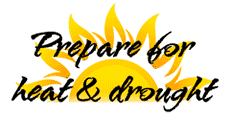
Association Perspective
Heat stress in black cattle.

It’s hard to believe we need to be thinking about preparing our black-hided beef animals for the heat after one of the coldest winters here in the Midwest. However, since we have a vested interest in black Angus cattle, we need to pay particular attention to potential heat stress that can occur during the next few months.
There are three steps in managing heat stress.
- 1. Identify those animals that are most susceptible to heat stress.
- 2. Have a plan in place to deal with heat-stressed animals.
- 3. Know when to take action when animals are heat-stressed or in trouble.
Identify high-risk animals
Step 1 includes identifying the animals that may have the highest risk of heat stress. That would include feedlot cattle close to their end point and heavily conditioned beef cows. Young and old animals also pose as high risk. Black-hided cattle are at greater risk than colored cattle. In fact, black-hided cattle typically have a 2° increase in body core temperature compared to lighter-colored cattle. These are the cattle that need priority evaluation during times of heat stress and should be in an area that can be addressed if problems arise.
Heat-stress action plan
Most importantly, animals need to have access to fresh, clean water during heat-stress conditions. In addition, there needs to be enough space for animals to drink without overcrowding. A good rule of thumb is to provide at least 2 inches (in.) of linear trough space per head.
If animals are to be fed during potential heat-stress conditions, move the animals’ feeding time to late afternoon or evening. This will allow rumen fermentation to take place during the cooler night temperatures, and it will increase lung capacity for the cattle during the hotter daytime temperatures. Normal digestive processes create heat in cattle. This body heat reaches a maximum several hours after the meal is consumed.
Air movement is beneficial to animals under heat stress to help with cooling. Although windbreaks and shelter belts offer protection during the winter, during heat-stress conditions they prohibit air movement and can make conditions worse.
In feedlot or drylot conditions, cooling the ground can be beneficial. Sprinklers are a good way to accomplish this; however, setting up sprinklers well in advance will help cattle adapt to them. Bedding can also provide some cooling if bedding is wetted prior to giving access to cattle.
If possible, provide shade. Animals will congregate in the shade to help cool their bodies. There are some shade options available for feedlot/drylot conditions that can be purchased or built.
Fly control is very important during heat stress as it causes unnecessary stress and bunching.
Although tempting at times, do not work cattle during increased heat-stress conditions. If it has to be done, work the cattle in the morning, keep stress at a minimum and provide adequate access to water. My best recommendation is not to work cattle in these conditions if possible.
Pay attention to the weather to prepare for heat-stress conditions with cattle, so if and when conditions arise, you can decrease potential performance losses and even death.
Know when to take action
Heat stress is caused by a combination of factors, including temperature and humidity. Animals are at highest risk when they don’t have the ability to cool down after an extremely hot day. They need to recover from that. Cattle are in risk of death from heat exposure when the following occur:
- The heat index is 75 or greater for a 72-hour period;
- The heat index during a 48-hour period is no lower than 79 during the day and no lower than 75 during the night; and
- The daytime heat index reaches 84 or higher for two consecutive days.
Editor’s note: Rod Geppert is the regional manager for Region 6, which includes the states of Minnesota, North Dakota and South Dakota. Click here to find the regional manager for your state.























